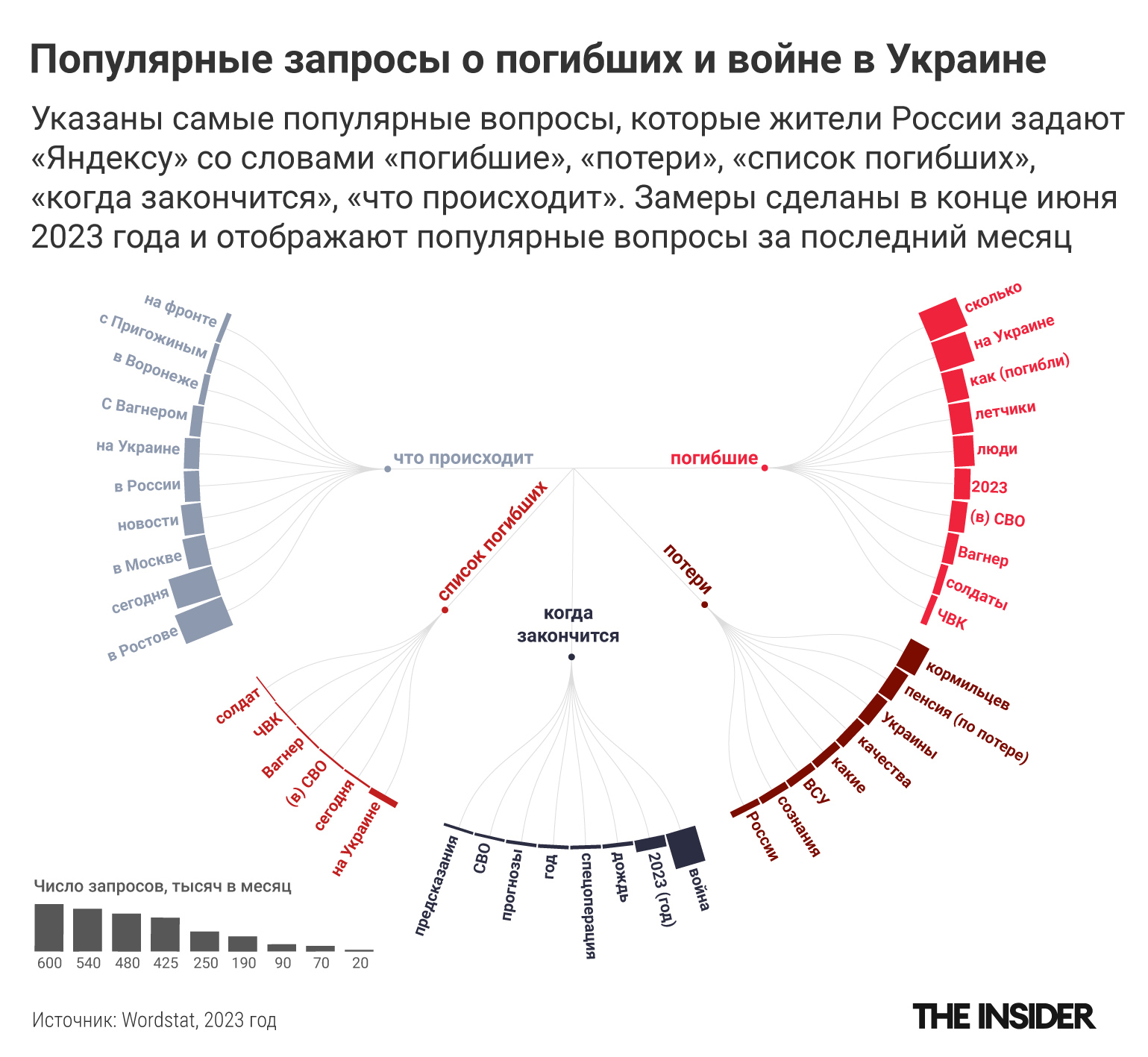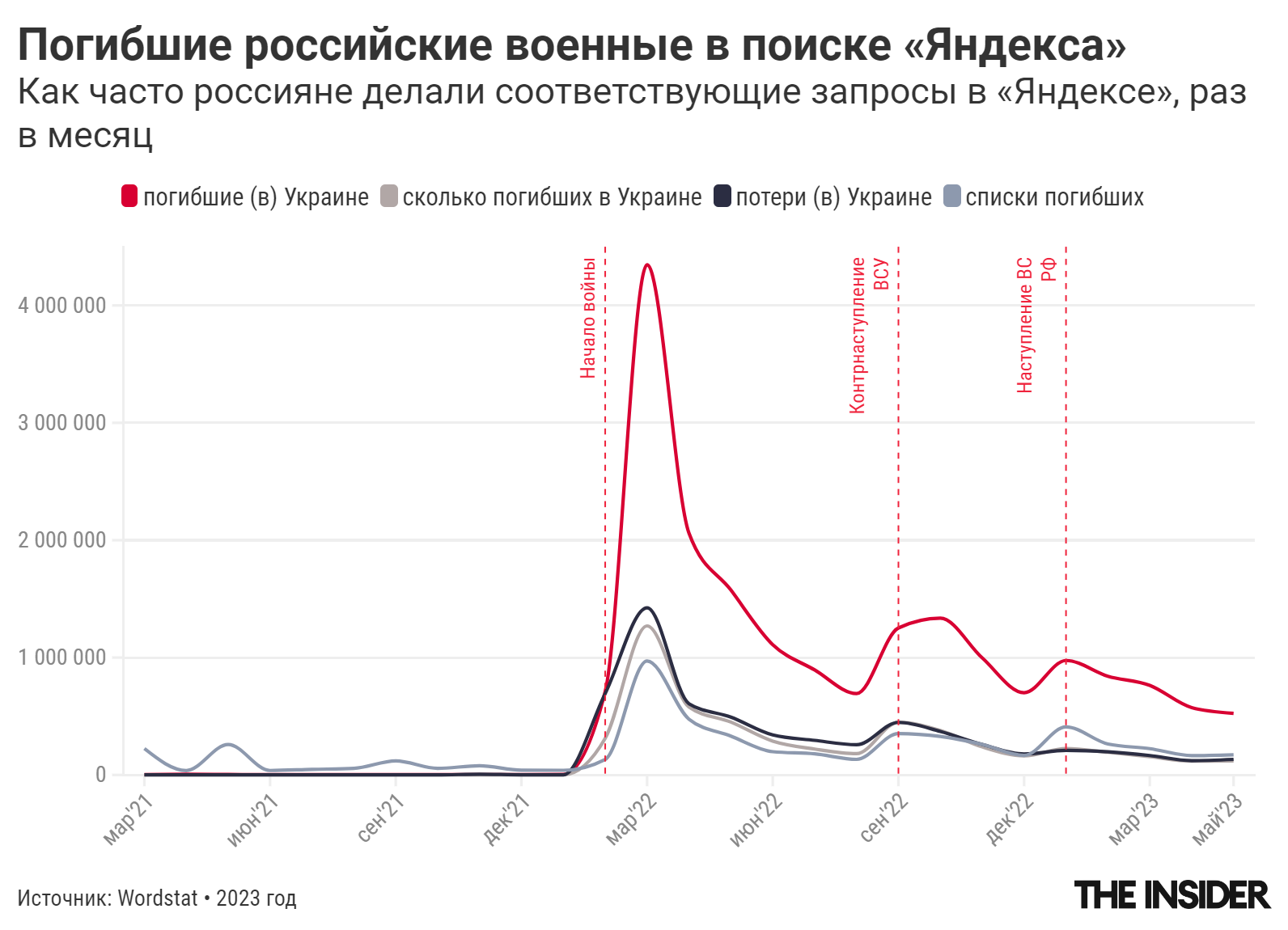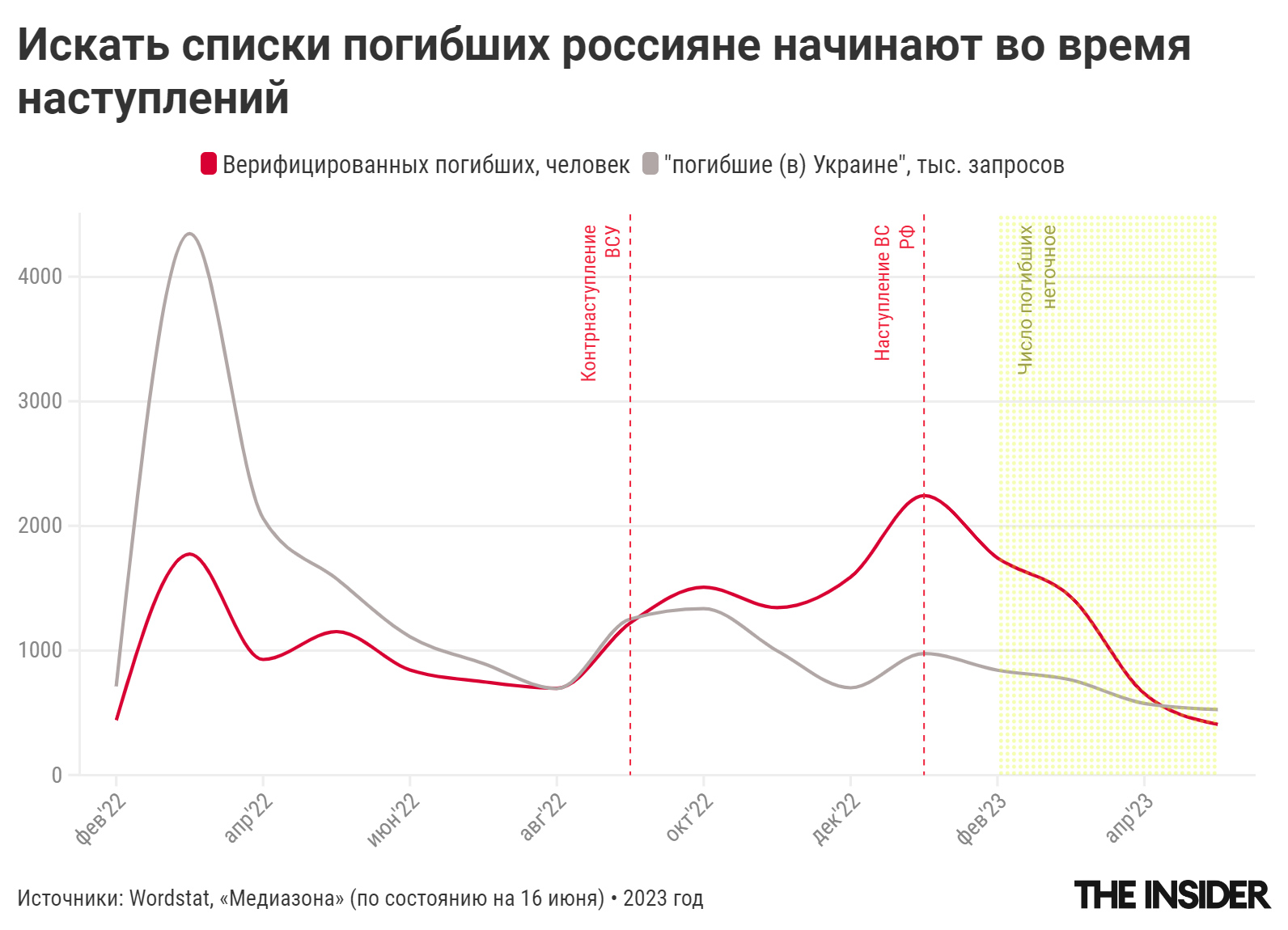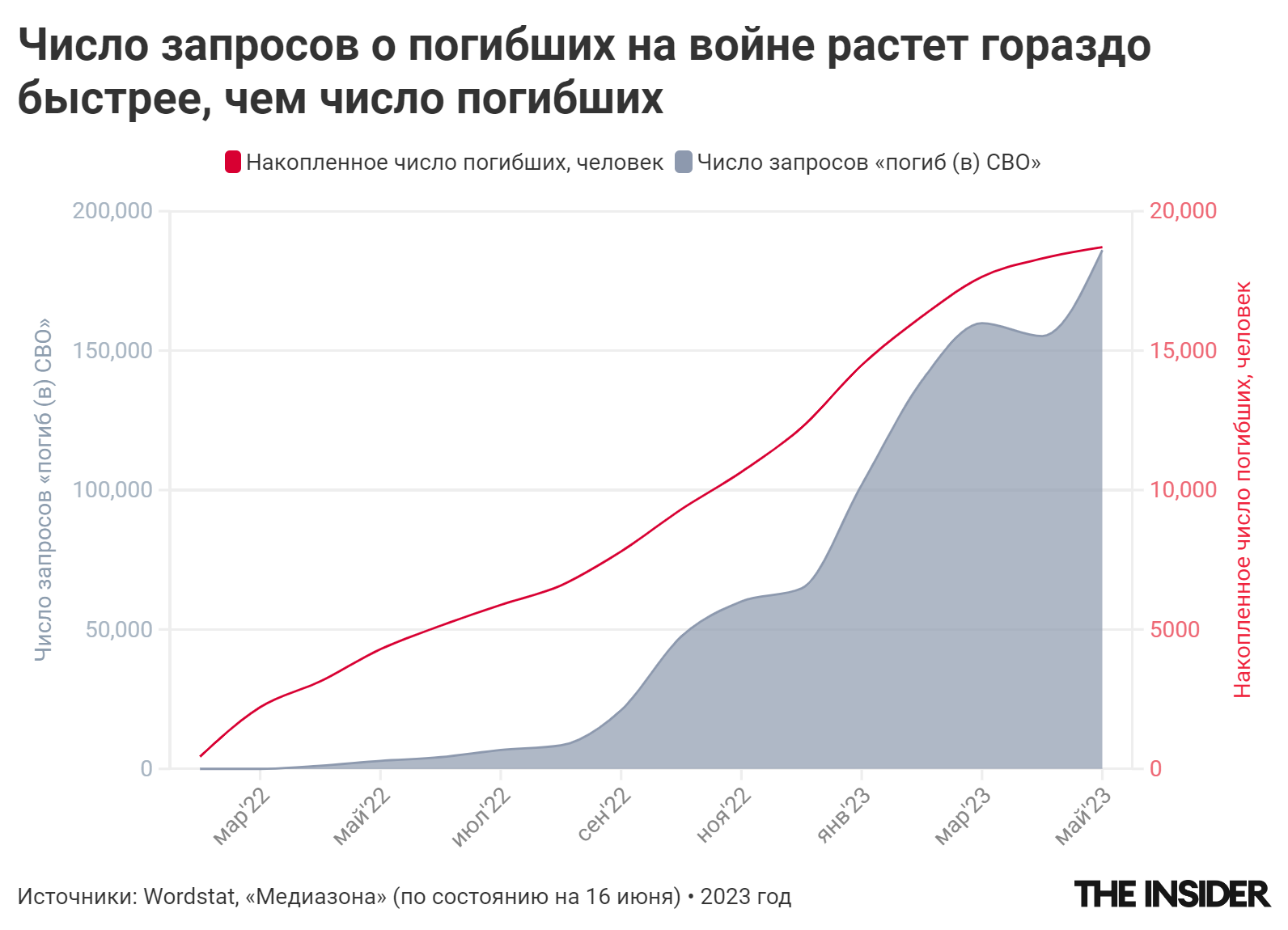How to see the dynamics of mortality at the front
The most accurate idea of the dynamics of mortality can be obtained through a group of queries such as “death(s) in the NWO”, “payments (for) the dead”, “lists of the dead”, and the like. Statistics on the number of requests was collected through the Yandex. Selection of words "- firstly, more than half of Russians use Yandex to search for information on the Internet, and secondly, only Yandex gives statistics on the number of search queries. We wrote requests in a special language of the service, but in the study we present them in a more “human” language. For example, for Yandex, the queries “killed their own” and “died in the NWO” are the same query, therefore, although the data was collected for the first formulation, we provide the second for readers.
To calculate the correlation with requests, we selected data on confirmed human losses, aggregated by months, which were taken from the Mediazones project and the BBC. On On June 16, 2023, the resources verified the names of 25.5 thousand Russian citizens who died in the war with Ukraine (including mercenaries). The real death toll is several times higher. According to the Conflict Intelligence Team, 40-60% of the buried dead are included in the lists, that is, the real number of buried may exceed 60 thousand people, and according to a study by Meduza and Mediazona, based on data on excess male mortality in Russia, the actual number of deaths is approximately 47 thousand. But it's not the total numbers that matter to calculate the correlation, but the dynamics of their change, and the Mediazona and BBC data are well suited for this.
For the analysis , linear regressions of the form Y=aX + B were used. The error of the regression coefficients was determined in a standard way at a 95% confidence level.

The lists of the dead and information about the losses in Ukraine are usually searched more actively when there is an offensive from one side or the other. Thus, the peak of the popularity of requests came in March 2022, during the first weeks of the invasion of Ukraine, when the Russian army suffered huge losses due to chaos and lack of control, as well as due to attempts to rapidly move towards the designated lines, regardless of the resistance of the Ukrainians. For example, it was then (or rather, at the very end of February) that a convoy of paratroopers was defeated in Bucha.

From the end of August, when the counter-offensive of the Armed Forces of Ukraine began in the Kherson region, and until its end in November, the lists of the dead were actively searched. A new wave of searches began in January, when Russia launched its own offensive – it ended with the capture of Bakhmut, but was accompanied by very heavy losses, including in other directions – for example, near Vuhledar, where, according to Ukrainian commanders, there was (once again) The 155th Marine Brigade of the Pacific Fleet was defeated . In early May 2023, the activity of Russians asking Yandex about the lists of the dead began to grow. Most often, such lists are sought in the Pskov and Kirov regions, Saratov, Ulan-Ude and Chita.
The statistics for this query are consistent with the verified data on the dead. That is, the more people die, the more people try to find information about the dead on the Internet. Using such information, we can preliminarily estimate the losses of the Russian army during offensives at the front.
Data on requests on the Internet reflects the situation at the front faster than it is seen by the team of volunteers from Mediazona and the BBC, whose database gets data on technical reasons with a delay of 2-3 weeks. “In January, we survived the crisis, as the losses increased many times over, our team of volunteers could not keep up with the flow of obituaries. We deal with about 1000 people a week. Many of the data that appeared in December-January, we were able to process and add only in March [2023],” says Dmitry Treschanin, editor of Mediazona. Judging by his words, the data on the number of deaths as of June, starting from January 2023, is already much more incomplete than the data for previous months. Therefore, although there is a decline in the data on verified deaths, in reality the number of buried military personnel and mercenaries is likely to increase. And it is precisely this picture – an increase in the number of searches for information about the dead – that we observe in search queries in Yandex.

Dissemination of information about the dead
The cumulative death toll increases linearly over time, but the number of monthly requests for "killed (in) NWO" grows exponentially. In fact, this means that more people are interested in the lists or the death toll in general (for example, the losses of the Russian army or Wagner PMC mercenaries) than their social circle – relatives, friends, and even just acquaintances. Otherwise, the number of such requests on the Internet would grow in proportion to the number of dead, that is, in arithmetic, not geometric progression.

In comparison, information about death benefits is searched much less frequently than about deaths, and these searches do not grow exponentially. In fact, how to get and how much the payments are, most likely, only those who knew the dead are looking for, and a wide range of Russians, who are increasingly concerned about high military losses, are interested in how many people died.
Recruited at least half a million people
Another interesting request in Yandex is “personal account of a serviceman”. A personal account is created for everyone who has signed a contract with the Ministry of Defense of the Russian Federation, even for a short time (those who have not signed a contract cannot do this). On the tenth or eleventh day of each month until the mobilization in September 2022, about 100 thousand people were looking for him – this number did not change with the outbreak of the war, that is, it was the same both before the war and after February 24, 2022. In the "personal account" the military will find out what salary they were charged in the past month. We found that since October 2022, 400-600 thousand people per month began to search for this site (later this number decreased to 200-300 thousand people per month, apparently, many simply stopped using the search engine to open the site). The surge in the search for a “personal account” is apparently associated with mobilization, when many recruits just started using it: the first major peak occurs in mid-October, the month when the first salary was owed to the mobilized (although not everyone still manages to get it). The difference of half a million people between those who usually looked for a “personal office” at the beginning of the war (100,000) and the maximum number that looked for it after mobilization (600,000) may roughly indicate the number of new recruits – about 500 thousand people.

Note that these data can help to roughly represent the minimum number of newly recruited, but not their total number – and even more so not the total number of military personnel, since not everyone enters the “personal account” through a search in Yandex, someone enters directly , someone uses Google, someone enters through the application, and someone receives pay slips directly to the mail.
What else is interesting about Russian society and its moods can be found in search queries,
read in the next article.


